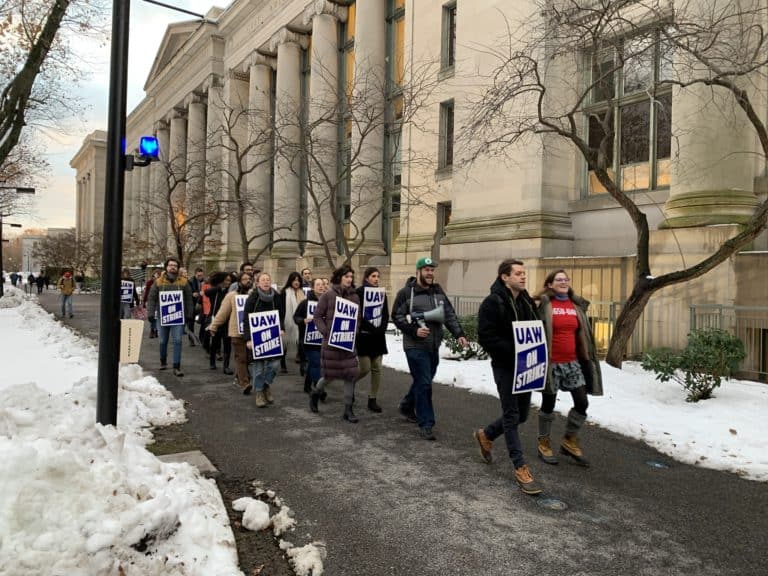
Benjamin Sachs is the Kestnbaum Professor of Labor and Industry at Harvard Law School and a leading expert in the field of labor law and labor relations. He is also faculty director of the Center for Labor and a Just Economy. Professor Sachs teaches courses in labor law, employment law, and law and social change, and his writing focuses on union organizing and unions in American politics. Prior to joining the Harvard faculty in 2008, Professor Sachs was the Joseph Goldstein Fellow at Yale Law School. From 2002-2006, he served as Assistant General Counsel of the Service Employees International Union (SEIU) in Washington, D.C. Professor Sachs graduated from Yale Law School in 1998, and served as a judicial law clerk to the Honorable Stephen Reinhardt of the United States Court of Appeals for the Ninth Circuit. His writing has appeared in the Harvard Law Review, the Yale Law Journal, the Columbia Law Review, the New York Times and elsewhere. Professor Sachs received the Yale Law School teaching award in 2007 and in 2013 received the Sacks-Freund Award for Teaching Excellence at Harvard Law School. He can be reached at [email protected].
Andrew Strom, Associate General Counsel of SEIU Local 32BJ, writes in with this guest post:
I am often struck by how opponents of labor unions worry so little about making contradictory arguments. For instance, when the National Labor Relations Board proposed two modest rule changes – one to require employers to post notices informing workers of their rights, and a second to eliminate some procedural roadblocks that allowed employers to delay representation elections, the Chamber of Commerce made one argument against the notice posting rule, and the opposite argument against the election rule. In a court brief, the Chamber asserted that the notice posting rule was unnecessary because “the data indicate that employees can easily get information about their rights under the NLRA,” including information about how to form a union. But, in opposing the election rule, the Chamber insisted that shortening the pre-election period would “depriv[e] employers of a fair opportunity to explain to employees the costs of unionizing.”
I’ve noticed the same sort of contradictory arguments in two other high profile cases. In Specialty Healthcare, the NLRB clarified the circumstances under which a clearly identifiable group of workers can form a union without including other workers who work for the same employer. The Chamber and its allies attacked the decision as authorizing “micro-units,” and argued that allowing smaller groups of workers to unionize would “impose unnecessary costs on the business community and burden the economy with repetitious bargaining, more frequent strikes and slowdowns, and jurisdictional disputes between the various unions that may represent the separately organized groups of employees.” The Chamber further argued that if employers have to negotiate separately with a number of different unions, the costs would not only be borne by employers, but also by “the employer’s shareholders, creditors, suppliers, and customers.”
Now, in Harris v. Quinn, the petitioners are attacking the very concept of exclusive representation, arguing that at least in the public sector, it violates the First Amendment rights of employees to require them to associate with a bargaining representative they did not choose. The Harris petitioners and their allies are making an argument that is the polar opposite of the argument made by the Chamber in Specialty Healthcare. While the Chamber feared that requiring an employer to bargain with a different union for each identifiable group of workers would impose unwarranted burdens on the economy, the Harris petitioners want a system where public employers would bargain separately with dozens of splintered ideological groups representing the competing interests of subgroups of workers. Not surprisingly, the Harris petitioners have little support from anyone with actual experience representing either employers or workers in collective bargaining.
The attacks on Specialty Healthcare were largely based on a caricature of the Board’s decision. Whoever came up with the term “micro-units” should be congratulated for their clever turn of phrase, but the facts cannot be squared with the label. In Specialty Healthcare, the union petitioned for a unit of 53 certified nursing assistants, a bargaining unit that was larger than the median unit approved by the Board in previous years. But, the larger point made by the Chamber has some validity – when it comes to collective bargaining, there can be economies of scale. Representative democracy is always going to be a little messy – the Supreme Court once observed that “[t]he complete satisfaction of all who are represented is hardly to be expected.” But, when a union does its job right, it gives all workers a chance to be heard, and it provides workers with a democratic forum for working through their differences before they present a united front to the employer. Any alternative to exclusive representation should be measured by whether it gives workers a similar opportunity to bargain as equals with their employer.






Daily News & Commentary
Start your day with our roundup of the latest labor developments. See all
November 28
Lawsuit against EEOC for failure to investigate disparate-impact claims dismissed; DHS to end TPS for Haiti; Appeal of Cemex decision in Ninth Circuit may soon resume
November 27
Amazon wins preliminary injunction against New York’s private sector bargaining law; ALJs resume decisions; and the CFPB intends to make unilateral changes without bargaining.
November 26
In today’s news and commentary, NLRB lawyers urge the 3rd Circuit to follow recent district court cases that declined to enjoin Board proceedings; the percentage of unemployed Americans with a college degree reaches its highest level since tracking began in 1992; and a member of the House proposes a bill that would require secret ballot […]
November 25
In today’s news and commentary, OSHA fines Taylor Foods, Santa Fe raises their living wage, and a date is set for a Senate committee to consider Trump’s NLRB nominee. OSHA has issued an approximately $1.1 million dollar fine to Taylor Farms New Jersey, a subsidiary of Taylor Fresh Foods, after identifying repeated and serious safety […]
November 24
Labor leaders criticize tariffs; White House cancels jobs report; and student organizers launch chaperone program for noncitizens.
November 23
Workers at the Southeastern Pennsylvania Transportation Authority vote to authorize a strike; Washington State legislators consider a bill empowering public employees to bargain over workplace AI implementation; and University of California workers engage in a two-day strike.